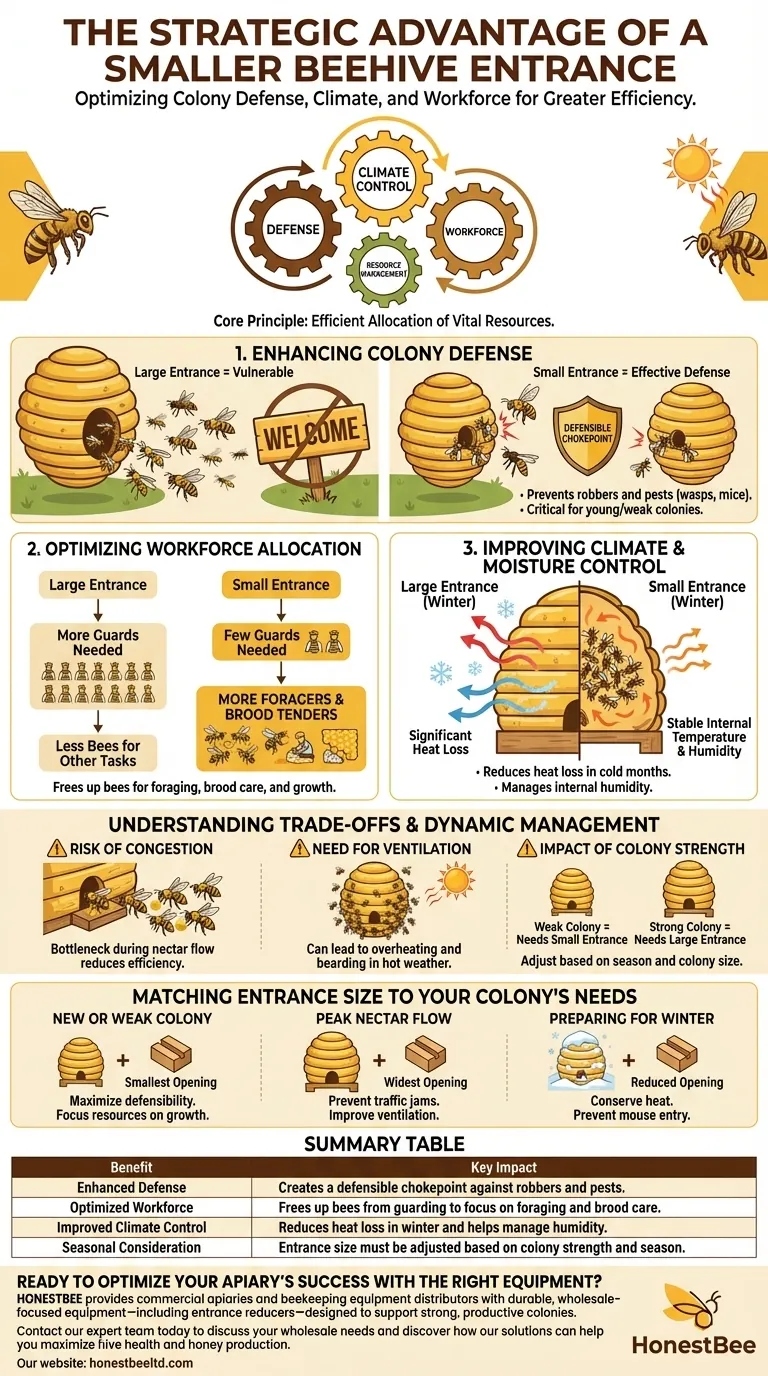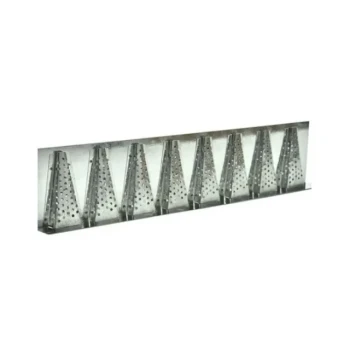In beekeeping, a smaller hive entrance is a fundamental strategy for improving a colony's defense and efficiency. By reducing the size of the opening, beekeepers make the hive easier for the bees to guard against predators and robbers, conserve critical heat during cold weather, and reallocate workers from guarding to more productive tasks like foraging.
The core principle is resource management. A smaller entrance allows a bee colony to more efficiently allocate its three most vital resources: defense, climate control, and its workforce.

The Strategic Advantage of a Reduced Entrance
Adjusting the hive entrance is one of the most impactful, low-effort actions a beekeeper can take. It directly influences the colony's ability to protect itself and regulate its internal environment.
Enhancing Colony Defense
A large, open entrance is a "welcome" sign for intruders. A smaller opening creates a defensible chokepoint that a few guard bees can effectively patrol.
This is critical for fending off robbing bees from other colonies, as well as pests and predators like wasps or mice. For a young or weak colony, a reduced entrance can be the difference between survival and collapse.
Optimizing Workforce Allocation
Every bee dedicated to guarding the entrance is one less bee available for other essential jobs. A smaller, more defensible entrance reduces the number of guards the colony needs to post.
This frees up a significant portion of the workforce to focus on foraging for nectar and pollen, tending to the brood, or building comb, directly contributing to the colony's growth and productivity.
Improving Climate and Moisture Control
The hive entrance plays a major role in hive ventilation and temperature regulation. A smaller opening significantly reduces heat loss during cold months.
This helps the colony maintain the stable internal temperature required to keep the cluster warm in winter and raise brood in the spring. It also influences airflow, which is essential for managing internal humidity.
Understanding the Trade-offs
While beneficial, a small entrance is not a year-round, set-it-and-forget-it solution. The ideal size changes with the season and the colony's strength.
The Risk of Congestion
During a strong summer nectar flow, a small entrance can become a bottleneck. Foraging bees get stuck in traffic jams, reducing the efficiency of their trips and slowing down honey production.
The Need for Ventilation
In hot weather, a restricted entrance can limit the airflow needed to cool the hive. This can lead to overheating and cause bees to "beard," or cluster on the outside of the hive, instead of working inside.
The Impact of Colony Strength
A large, thriving colony has thousands of bees and can easily defend a larger entrance. In fact, it needs a larger entrance to accommodate its high level of foraging traffic and ventilation requirements. Conversely, a small hive needs the protection of a reduced entrance.
Matching Entrance Size to Your Colony's Needs
Your goal is to provide the right-sized entrance for your colony's specific situation. Use an entrance reducer—a simple block with different-sized openings—to make these adjustments.
- If you are establishing a new or weak colony: Use the smallest entrance setting to maximize defensibility and help the colony focus its resources on growth.
- If your colony is strong during a peak nectar flow: Open the entrance to its widest setting to prevent traffic jams and improve ventilation, maximizing foraging efficiency.
- If you are preparing for winter: Reduce the entrance to conserve heat and prevent mice from seeking shelter inside the warm hive.
By actively managing the hive entrance, you transition from simply housing bees to strategically guiding their success throughout the year.
Summary Table:
| Benefit | Key Impact |
|---|---|
| Enhanced Defense | Creates a defensible chokepoint against robbers and pests. |
| Optimized Workforce | Frees up bees from guarding to focus on foraging and brood care. |
| Improved Climate Control | Reduces heat loss in winter and helps manage humidity. |
| Seasonal Consideration | Entrance size must be adjusted based on colony strength and season. |
Ready to optimize your apiary's success with the right equipment?
Strategic hive management starts with quality supplies. HONESTBEE provides commercial apiaries and beekeeping equipment distributors with durable, wholesale-focused beekeeping equipment—including entrance reducers—designed to support strong, productive colonies.
Contact our expert team today to discuss your wholesale needs and discover how our solutions can help you maximize hive health and honey production.
Visual Guide

Related Products
- Beehive Entrance Reducer Guardian Metal Hive Entrance for Bees
- Multi-Functional Sliding Hive Entrance for Beekeeping
- Steel Round Disc Entrance Reducer for Flexzion Bee Hive Nuc Box Gate
- Multi-Functional Rotary Hive Entrance Disc for Beekeeping
- Professional Reversible Beehive Hive Entrance
People Also Ask
- What are the features of the side with oblong holes in the entrance reducer? A Guide to Hive Defense & Health
- What are the two functions of the Entrance Reducer? Master Hive Defense and Safe Transport
- What should be done after transferring frames to the new hive? Essential Steps for a Secure Colony
- What is the purpose of placing an object in front of the hive entrance after a move? A Guide to Forced Reorientation
- How can a Langstroth hive entrance be adjusted? Mimic Natural Bee Preferences for a Healthier Hive



















